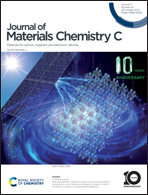Bluish-green-to-green thermally activated delayed fluorescent emitters based on β-diketone derivatives exhibiting a horizontal emission dipole orientation ratio of 88% and an external quantum efficiency of nearly 25%†
Abstract
Despite the promising photofunctionalities of β-diketone-based thermally activated delayed fluorescent (TADF) emitters, such as excited-state intramolecular proton transfer and the utilization of the ligand in the emissive metal complex, examples in the blue region are scarcely explored. To achieve a shorter wavelength emission, three variations of β-diketone/tetramethylcarbazole conjugated TADF emitters, designated as MCzX derivatives, were synthesized, and showed bluish-green-to green emission. Among these emitters, MCzDBM exhibited a photoluminescent quantum yield of 79% and a horizontal emission dipole orientation ratio of 88%, when incorporated into a phosphine-oxide-based host material, mCPPO. The consequent OLED has been evaluated to be highly efficient, with an external quantum efficiency of 24.6%. These performance parameters are the best among those reported thus far for β-diketone-based TADF emitters.



 Please wait while we load your content...
Please wait while we load your content...